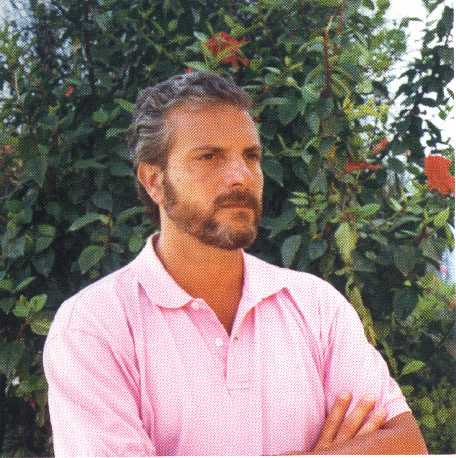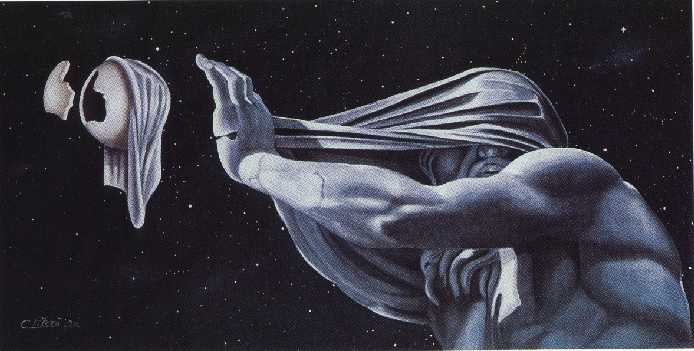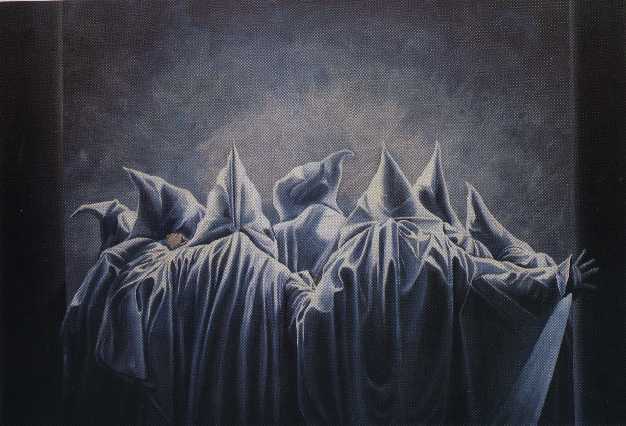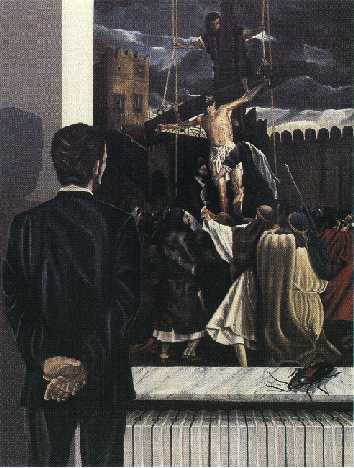

Nato a Belcastro (CZ) il 16 gennaio del 1955, Carlo Piterà risiede a Genova dal 1956. Ha studiato alla facoltà di architettura che abbandonerà per dedicarsi alla pittura.
Risale all'infanzia la precocissima vocazione artistica che lo induce particolarmente all'interesse per la pittura e alla visita delle più importanti pinacoteche genovesi per studiare le opere degli antichi maestri.
Autodidatta, prosegue una continua ricerca ed elaborazione dì idee che lo porterà a considerare come fatto primario il Surrealismo. Si interessa all'anatomia umana, alle leggi del colore, al disegno architettonico, unendo così all'estro e all'emotività un solido bagaglio di ricerca ed esperienza formale.
Partecipa su invito a importanti collettive a carattere nazionale conseguendo successi ed aggiudicandosi importanti premi. Nel 1976 inizia un più diretto rapporto col pubblico; presenta la sua prima. personale. Scriverà di lui Franca Bissoni in quell'occasione " ... La realizzazione si avvale di un'abilità tecnica indubbiamente superiore all'età dell'artista, il quale sembra aver assimilato con profitto la lezione del Surrealismo storico".
Continuando a dipingere avverte la necessità di una costante verifica e di una continua revisione tecnica ed espressiva. Conseguentemente sospende per qualche tempo le esposizioni riducendosi in un isolamento estremamente utile e produttivo.
Nel 1978 e '79 riprende l'attività pubblica, e c'è chi osserva come la sua sia una prova di forza atta a riassumere le molteplici proiezioni della verità immaginativa.
Nel 1986 Pietro Annigoni, apprezzando "le sue fantasie conturbanti e il modo diretto di evidenziarle", lo incita ad approfondire la ricerca realistica nelle sue opere, e il critico d'arte Vitaliano Rocchiero lo definisce "padrone assoluto dell'irrealtà della realtà".
Sempre nell'86 incontra il mercante d'arte di Verona Giorgio Ghelfi che gli offre l'opportunità di esporre nelle sue gallerie di Verona e Montecatini Terme pubblicando per l'occasione una monografia con la presentazione critica di Enzo Fabiani.
Negli anni successivi la sua ricerca pittorica volge allo studio approfondito dei Maestri del '500 e '600. Infatti la sua più recente produzione denota una elaborazione concettuale e stilistica di marca neomanieristica e citazionistica senza tralasciare, per altro, l'invenzione e le peculiarità fenomeniche del Surrealismo storico.
[Numerose riproduzioni di quadri dell'artista si trovano
nella rivista Anthropos & Iatria che viene presentata nella
sezione "Pubblicazioni ricevute" di questo stesso numero di Episteme:
http://www.dipmat.unipg.it/~bartocci/ep6/ep6-pubric.htm ]

Il velo, 1990
(Olio su tela, cm. 60 x 120, Collezione privata)
POESIA - ARTE VISIVA, Genova 1978
BOLAFFI CATALOGO NAZIONALE N. 14, Torino 1979
GRANDE DIZIONARIO DEGLI ARTIS'I'I ITALIANI CONTEMPORANEI,
Parma 1979
ANNUARIO COMANDUCCI N. 7, Milano 1980
BOLAFFI, CATALOGO NAZIONALE N. 15, Torino 1980
DIZIONARIO DEGLI ARTISTI EUROPEI CONTEMPORANEI, Parma
1980
ARTE ITALIANA PER IL MONDO, VOL. N. 7, CELIT, Torino
1981
MAESTRI D'ARTE NEL SECOLO, CIDA, Roma 1981
ANNUARIO COMANDUCCI N. 8, Milano 1981
L'ELITE - SELEZIONE ARTE ITALIANA, Varese 1981
REPERTORIO DEI PITTORI E DEGLI SCULTORI CALABRESI CONTEMPORANEI,
Catanzaro
KUNSTHISTORISCHE INSTITUT IN FLORENZ, ARCHIVIO PER L'ARTE
ITALIANA DEL NOVECENTO, Firenze
PITTORI SCULTORI ITALIANI CONTEMPORANEI, CIDAC, Cesena
Forlì 1981
GRANDE ENCICLOPEDIA DELL'ARTE ITALIANA CONTEMPORANEA,
VOL. II, CASA ED. ALBA, Ferrara 1982
CENTAURO D'ORO, ACCADEMIA ITALIA, Salsomaggiore Terme
1982
ARTE ITALIANA CONTEMPORANEA, LA GINESTRA EDITRICE, Firenze
1984
QUADERNI "ARTISTI ITALIANI D'OGGI" N. 380, EDIZIONI D'ARTE
GHELFI, Verona 1986
ANNUARIO COMED N. 13, Milano 1986
DIZIONARIO DEGLI ARTISTI LIGURI, DE FERRARI EDITORE,
Genova 1991
CATALOGO INTERNAZIONALE D'ARTE CONTEMPORANEA, CASA EDITRICE
ALBA, Ferrara 1991-92
REALIZZAZIONE DI 53 TAVOLE BOTANICHE ANATOMICHE A COLORI
PER L'ILLUSTRAZIONE DEL LIBRO "COMPENDIO DI GEMMOTERAPIA CLINICA" DI FERNANDO
PITERÀ, DE FERRARI EDITORE, Genova 1991
ANNUARIO EIAC, ARTE STUDIO, Firenze 1992
DIZIONARIO DEGLI ARTISTI LIGURI - APPENDICE, DE FERRARI
EDITORE, Genova 1994
REPERTORIO ILLUSTRATO DEGLI ARTISTI LIGURI, DE FERRARI
EDITORE, Genova 1995
ART SHOW 97 CATALOGO, Genova 1997
CD-ROM - DIZIONARIO DEGLI ARTISTI LIGURI, DE FERRARI
EDITORE, Genova 1998.

La setta, 1986
(Olio su tela, cm. 150 x 100, Collezione privata)
Carlo Piterà was born in Belcastro, a village in the province of Catanzaro, on January 16, 1955. In 1956 his family moved to Genoa. He took up architectural studies which he later quit to devote himself to painting.
His precocious bent for art dates back to childhood, when he showed a particular interest in painting and visited major Genoese art galleries with the purpose of approaching the works of ancient masters.
A self-taught man, he continuously sought for ideas to elaborate, an attitude of mind that led him to attributing a major role to Surrealism. He generated a particular interest in human anatomy, the laws of colour and architectural drawing, thus marching talent and emotionality with sound research and formal experience.
He was invited to many national art shows, was met with success and won several prizes. In 1976 ho decided to establish a closer relationship with the public and presented his first solo exhibition. On that occasion, Franca Bissoni wrote: "The works show advanced technical skills, especially considering the age of the artist. He seems to have successfully assimilated the lessons of historical Surrealism".
His painting activity continued, but he began to feel the need for a constant evaluation and a continuous revision of his technique and form of expression. He therefore decided to withdraw from public activity for a while and retired into complete isolation: a decision that proved extremely useful and productive.
In 1978/79 ho began exhibiting his paintings again, leading some critics to considcr his work as a show of strength aimed at summing up the different projections of imaginative truth.
In 1986 Pietro Annigoni expressed bis appreciation for the artist's "perturbing daydreams and direct way to emphasize them" and urged him to intensify realistic research in his works. The art critic Vitaliano Rocchiero defined him as an "absolute master of imagination and reality".
In 1986 he also met the Veronese art merchant Giorgio Ghelfi, who offered him the opportunity to exhibit his works in Ghelfì's galleries in Verona and Montecatini Terme. On that occasion, Ghelfi also published a monography of the artist with an introduction by art critic Enzo Fabiani.
In the following years, Piterà pursued in-depth
pictorial research of the masters of the l6th and 17th centuries. As a
matter of fact, the stylistic and conceptual framework of his latest production
bears the mark of Neo-mannerism and quotational trends, without overlooking
the inventive and peculiar phenomena of historical Surrealism.

Pilato, 1990
(Olio su tela, cm. 150 x 200)
* * * * *
Sepolcri, 1999
(Olio su tela, cm. 171 x 117, Collezione privata)
(Il dipinto è stato riprodotto alla pag. 5 della
già nominata rivista Anthropos & Iatria,
Anno IV, N. 4, Ottobre-Dicembre 2000)
Fuse da quale terrore,
da quale miracolo,
quali fuochi, quali luci
hanno smembrato
nella collera bianca
della loro accusa
quelle due torri d'argento e d'acciaio?
(Thomas Merton)
[Cfr. in questo stesso numero di Episteme: Arcangelo
Papi, "Il caso Majorana - L'<<ipotesi Klingsor>>",
http://www.dipmat.unipg.it/~bartocci/ep6/ep6-papi2.htm]